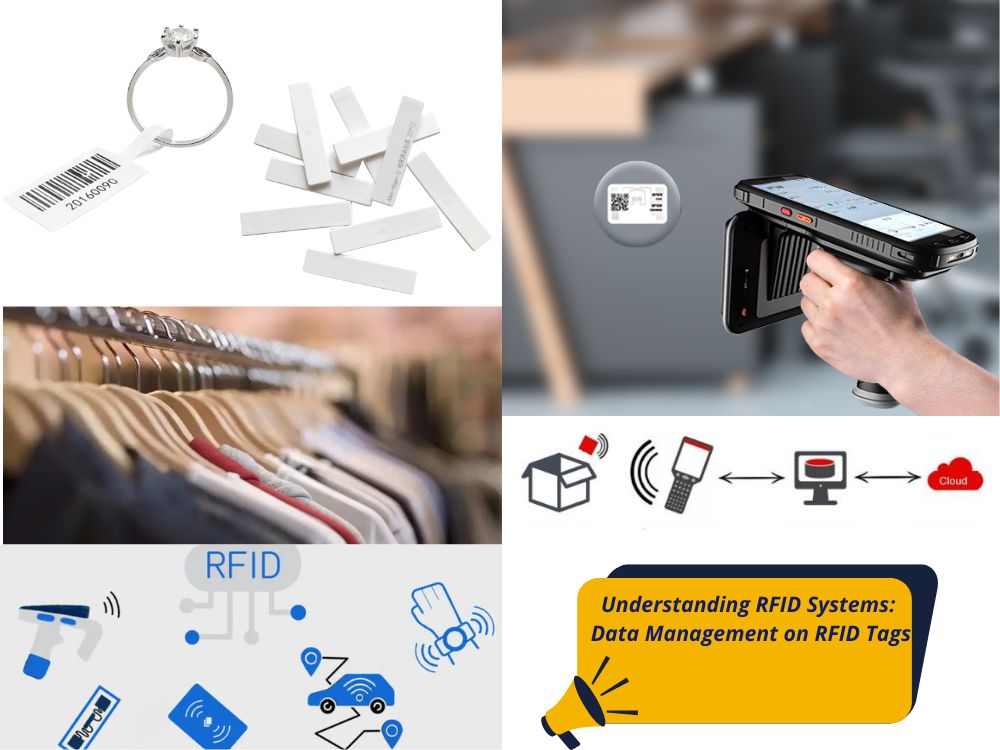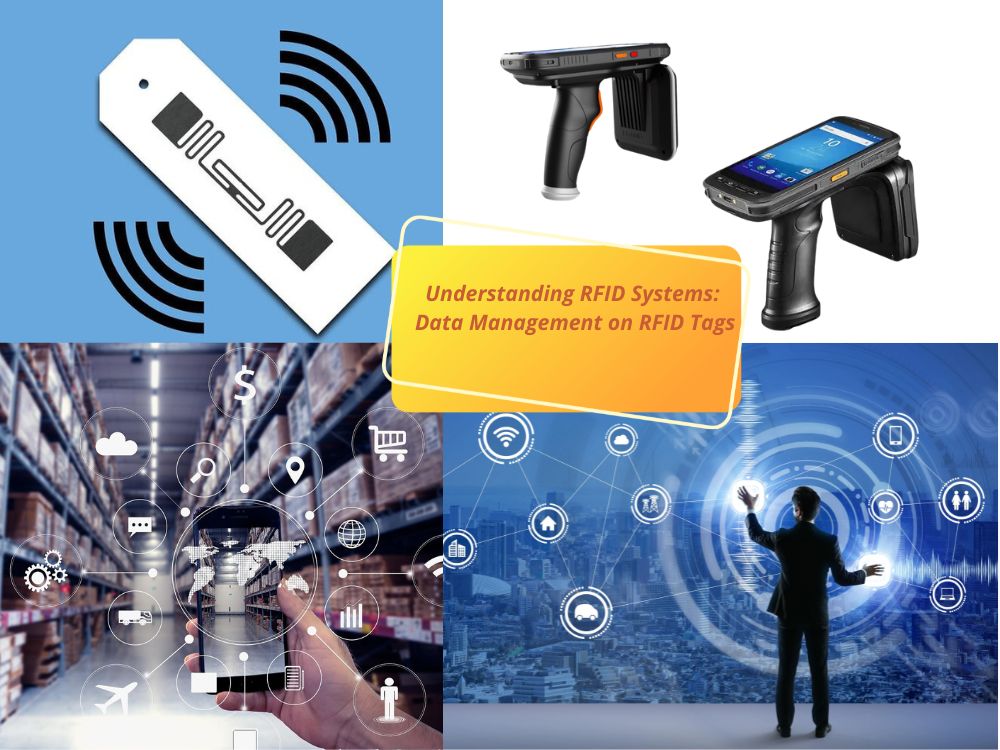
Understanding RFID Systems: Data Management on RFID Tags
Table of Contents
Summary
They provide a sophisticated means of identifying and monitoring items through the use of RFID tags. These tags can store a modest amount of data, but their primary function is to link to a more extensive central database, where detailed information is maintained and updated.
This article explores the mechanisms behind data storage on RFID tags and highlights why central databases are preferred for storing dynamic information. The discussion will cover the limitations of tag-based storage and the advantages of maintaining data in a centralized system.

The Role of RFID Tags in Data Storage
RFID tags are integral components of RFID systems, designed to provide unique identification for each item to which they are attached. Despite their capabilities, the data they store is typically minimal compared to what is held in a central database. Here’s an overview of how RFID tags function in the context of data management:
- Tag-Based Data Storage:RFID tags contain chips that can hold around 2 kilobytes of data. This storage is sufficient for static information such as a unique identifier or serial number. Tags can be both read from and written to, allowing for some flexibility in the data they contain.
- Dynamic Data Handling:While RFID tags can store limited dynamic data, it is generally more practical to keep this information in a central database. Tags are primarily used for static data, such as an item’s unique ID, which remains unchanged.
Why Central Databases Are Preferred for Data Storage
Storing data on a central database rather than on the RFID tag itself offers several significant advantages:
Security
Data stored in a central database benefits from advanced security protocols. Centralized systems can implement rigorous validation checks, access controls, and encryption measures to safeguard sensitive information. In contrast, data on an RFID tag is more vulnerable to unauthorized access and tampering.
Accessibility
A central database provides greater accessibility to data. Authorized users can access the information from any location, given proper permissions. This flexibility is essential for large-scale operations where data needs to be shared across different departments or geographic locations. On the other hand, data stored on an RFID tag is only accessible when the tag is within the range of an RFID reader.

Data Recovery
Central databases offer robust data recovery solutions. Data can be backed up regularly, and recovery procedures are in place to restore information in case of corruption or loss. RFID tags do not have the same recovery capabilities; if a tag is damaged or its data is corrupted, recovery of the information can be challenging, potentially disrupting operations.
Best Practices for RFID Data Management
To optimize the effectiveness of RFID systems, it is advisable to follow these best practices:
- Use Tags for Static Data:Store static information, such as unique identifiers, on the RFID tags. This ensures that the tag serves its primary function of identification without the complexity of handling dynamic data.
- Centralize Dynamic Data:Maintain dynamic and detailed information, such as product history or real-time status updates, in a central database. This approach ensures data security, accessibility, and recovery.
- Regular Updates and Backups:Ensure that the central database is regularly updated and backed up to maintain data integrity and availability.
Comparison of Data Storage on RFID Tags vs. Central Databases
Feature | RFID Tag Storage | Central Database Storage |
Data Capacity | ~2 KB of static data | Extensive capacity for dynamic data |
Security | Basic security measures | Advanced security protocols |
Accessibility | Limited to reader range | Accessible from any authorized location |
Data Recovery | Difficult to recover | Robust backup and recovery systems |
Conclusion
In summary, while RFID tags are crucial for identifying and tracking items, the storage of comprehensive and dynamic data is more effectively managed through central databases. By leveraging the strengths of both RFID tags and central databases, organizations can enhance their data management systems, ensuring security, accessibility, and reliability.
Comments
Hot Products

What Is RFID Waste Management
Imagine a city where every trash bin speaks — not literally — but through a tiny chip that tells the system when it’s full, when it’s emptied, and where it went. That’s what RFID waste management is doing today.

What are Bolt Seals and their Applications? | Complete Guide
In global trade and logistics, bolt seals play a crucial role in ensuring cargo security and compliance. These small but powerful devices are designed to lock shipping containers, trailers, and cargo doors with a tamper-evident mechanism.

What is an RFID Card Protector? Benefits, Use Cases, and Buying Guide
RFID technology (Radio Frequency Identification) is everywhere: in your credit cards, ID badges, transit passes, hotel room keys, and more. It offers speed and convenience, but it also opens the door to a new kind of digital theft called “skimming.” That’s where an RFID card protector comes in.

RFID Wristbands for Events: Bulk Buying Guide for Organizers
RFID wristbands for events are becoming the go-to solution for organizers who need faster entry, fraud prevention, and cashless payments at concerts, festivals, and sports venues. Unlike paper tickets or QR codes, these smart wristbands use embedded chips to streamline access, secure transactions, and improve the guest experience.

How RFID Tag on Windscreen Improves Vehicle Access Control and Toll Systems
In today’s fast-paced world, vehicle identification needs to be quick, secure, and contactless. An RFID Tag on the Windscreen provides exactly that — a reliable way to manage toll collection, parking, and gated access without stopping vehicles.

The Benefits of RFID Linen Tags in Commercial Laundry
Managing laundry in hospitals, hotels, or large laundry services is a big job. Each day, thousands of sheets, towels, and uniforms are washed, sorted, and sent back out. But problems like lost linens, sorting mistakes, and manual counting can cost companies a lot of money. For example, mid-sized hotels can lose over $200,000 each year from missing linens.
That’s where RFID Linen Tags come in.
Tags
RELATED BLOGS

What Is RFID Waste Management
Imagine a city where every trash bin speaks — not literally — but through a tiny chip that tells the system when it’s full, when it’s emptied, and where it went. That’s what RFID waste management is doing today.

What are Bolt Seals and their Applications? | Complete Guide
In global trade and logistics, bolt seals play a crucial role in ensuring cargo security and compliance. These small but powerful devices are designed to lock shipping containers, trailers, and cargo doors with a tamper-evident mechanism.

What is an RFID Card Protector? Benefits, Use Cases, and Buying Guide
RFID technology (Radio Frequency Identification) is everywhere: in your credit cards, ID badges, transit passes, hotel room keys, and more. It offers speed and convenience, but it also opens the door to a new kind of digital theft called “skimming.” That’s where an RFID card protector comes in.




